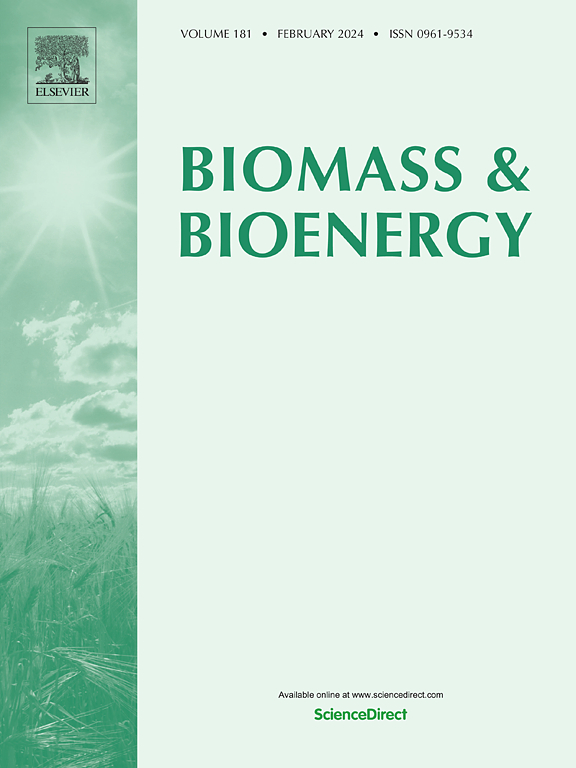Effects of stand characteristics, topography, and management regime on biomass and volume of Eucalyptus globulus plantations in Ethiopia's Northeast Highlands
IF 5.8
2区 生物学
Q1 AGRICULTURAL ENGINEERING
引用次数: 0
Abstract
Despite the rapid expansion of E. globulus due to its biomass and other commercial benefits in the Ethiopian highlands, the factors influencing its biomass productivity remain insufficiently studied, which is critical for its sustainable biomass and bioenergy production and utilization. This study evaluates the productivity of E. globulus plantations with managerial, topographic, and socioeconomic factors in the northeastern Ethiopian highlands. The data on stand age, plantation scale, stand originality, slope, and aspect from 76 plots, alongside a questionnaire survey on 225 respondents. The study utilized MANOVA, multiple regression model, and X2 test for analysis. A significant interaction effect (p < 0.001) was observed in plantation productivity among stand characteristics, age, topographic, and socioeconomic contexts. Large-scale coppice plantations at age six, foot slope, and northeast aspect exhibited the highest mean annual increment of 5.8 m3ha−1year−1, total biomass of 28.6 Mg ha−1, and volume of 29.7 m3 ha−1. The stand age with foot slope, and northeast aspect have a great influence (p < 0.001, Adj. R2 = 75 %, and RMSE = 1.57) on productivity of E. globulus plantation. The 98.2 % of respondents indicated that E. globulus plantations are established on marginal lands, characterized by low management intensity, quality, and productivity. Large-scale coppice plantations exhibit greater volume and biomass relatively, whereas its productivity was lower than central highlands of Ethiopia, Australia, and Brazil. The decline in biomass productivity is attributed to insufficient management and a low in extension services, highlighting the urgent need for skill development and policy reforms within the biomass plantation sector.
埃塞俄比亚东北高地林分特征、地形和管理制度对蓝桉人工林生物量和体积的影响
尽管由于其生物量和其他商业利益,E. globulus在埃塞俄比亚高地迅速扩大,但影响其生物量生产力的因素仍未得到充分研究,这对其可持续的生物量和生物能源生产和利用至关重要。本研究从管理、地形和社会经济等因素对埃塞俄比亚东北部高原的球芽甘蓝人工林的生产力进行了评价。本文收集了76个样地的林龄、人工林规模、林分原始性、坡度和坡向数据,并对225名受访者进行了问卷调查。本研究采用方差分析、多元回归模型和X2检验进行分析。显著的相互作用效应(p <;0.001),在林分特征、年龄、地形和社会经济背景下,人工林生产力存在显著差异。6龄大尺度林分、坡脚和东北向的平均年增长量最高,为5.8 m3ha−1年−1,总生物量为28.6 Mg ha−1,体积为29.7 m3ha−1。坡脚林龄和东北向对林龄影响较大(p <;0.001,相对值R2 = 75%, RMSE = 1.57)。98.2%的回答者表示,金莲人工林建立在边缘土地上,其特点是管理强度、质量和生产力较低。相对而言,大规模灌木林具有更大的体积和生物量,但其生产力低于埃塞俄比亚、澳大利亚和巴西的中部高地。生物量生产力下降的原因是管理不足和推广服务不足,这突出表明迫切需要在生物量种植部门内进行技能发展和政策改革。
本文章由计算机程序翻译,如有差异,请以英文原文为准。
求助全文
约1分钟内获得全文
求助全文
来源期刊

Biomass & Bioenergy
工程技术-能源与燃料
CiteScore
11.50
自引率
3.30%
发文量
258
审稿时长
60 days
期刊介绍:
Biomass & Bioenergy is an international journal publishing original research papers and short communications, review articles and case studies on biological resources, chemical and biological processes, and biomass products for new renewable sources of energy and materials.
The scope of the journal extends to the environmental, management and economic aspects of biomass and bioenergy.
Key areas covered by the journal:
• Biomass: sources, energy crop production processes, genetic improvements, composition. Please note that research on these biomass subjects must be linked directly to bioenergy generation.
• Biological Residues: residues/rests from agricultural production, forestry and plantations (palm, sugar etc), processing industries, and municipal sources (MSW). Papers on the use of biomass residues through innovative processes/technological novelty and/or consideration of feedstock/system sustainability (or unsustainability) are welcomed. However waste treatment processes and pollution control or mitigation which are only tangentially related to bioenergy are not in the scope of the journal, as they are more suited to publications in the environmental arena. Papers that describe conventional waste streams (ie well described in existing literature) that do not empirically address ''new'' added value from the process are not suitable for submission to the journal.
• Bioenergy Processes: fermentations, thermochemical conversions, liquid and gaseous fuels, and petrochemical substitutes
• Bioenergy Utilization: direct combustion, gasification, electricity production, chemical processes, and by-product remediation
• Biomass and the Environment: carbon cycle, the net energy efficiency of bioenergy systems, assessment of sustainability, and biodiversity issues.
 求助内容:
求助内容: 应助结果提醒方式:
应助结果提醒方式:


